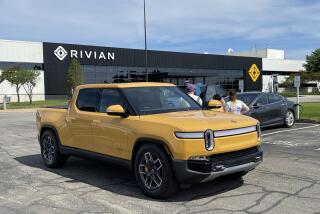VW Regains No. 1 Spot in Europe : 2nd-Generation Golf Model Given Much of the Credit
- Share via
WOLFSBURG, West Germany — Volkswagen, makers of the “Peoples’ Car,” has made a remarkable comeback from a dangerous slump and is now the No. 1 seller in Europe.
In 1985, Volkswagen-Audi sold almost 1.5 million cars, passing Fiat-Lancia and accounting for almost 13% of the European market.
This is heartening news for a company that attracted the world’s attention with its original Beetle model but went into the red in 1982 and remained there through 1984.
“In retrospect, 1984 was a year of consolidation for us, and 1985 began a phase of expansion reminiscent of the 1970s,” VW Chairman Carl Hahn said recently at Wolfsburg, the company headquarters and site of its largest plant. “I’m convinced that 1986 will be another big year for Volkswagen-Audi.”
Hahn and other executives see a number of factors as contributing to the dramatic turnaround, which produced profits last year estimated at $200 million. There has been a general improvement in car sales, notably in Italy and Spain, and VW’s second-generation Golf model has become the biggest single seller in West Germany, as well as in the rest of Europe.
Emphasized Quality
Further, VW has put greater emphasis on quality at its Westmoreland, Pa., plant, and the Golf model is winning favor among American buyers in a way that its predecessor, the Rabbit, had not done for years. VW sold 68,362 Rabbits in 1984, its last year of production, and 77,537 Golfs in 1985, that model’s introductory year, for an increase of 13.4%.
The Rabbit was damaging to the VW image of quality-engineering and no-nonsense design, officials here now concede.
When Hahn returned to VW in 1982--he had left in 1972 to head a West German tire manufacturer--he was appalled to find that the European Golf had been Americanized as the Rabbit and modified to please U.S. buyers.
The Rabbit, he thought, was too cute by half. He switched the name back to Golf, did away with interior frills and produced a car that concentrated on engineering and quality. In its last year, the Rabbit’s base price was $6,390, compared to $7,150 for today’s Golf.
Sales of the new Golf picked up in the United States, though nowhere near as sharply as in Europe. Last year’s total of 90,000 American-produced cars was almost rivaled by the hot-moving Jetta, which is imported into the United States from Wolfsburg.
“We now know that an American buyer of a Volkswagen prefers its European heritage,” an official here commented.
VW also hopes to win a larger share for its up-market Audi Quattro, which accounted for 20% of VW sales last year and brought in 33% of the profits. Each Audi contributes about 50% more profit than each Golf.
New Model to Debut
Last year, VW sold 2.4 million vehicles worldwide, including 170,000 vans and 370,000 Audis. This year it plans to introduce a jazzy new Golf with a 16-valve injection engine that officials predict will be a hot item in Europe.
“It’s got more power and is still very economical in fuel consumption,” said Ortwin Witzel, a senior executive here. “Top speed will be well over 200 kilometers-an-hour”--about 120 m.p.h.
The speed is expected to appeal to German buyers. On Germany’s autobahns, or expressways, there is no speed limit. The other side of the coin, however, is that sales of the regular Golf GTI have been sluggish this spring as buyers wait for the new model.
Late this year, the company plans to bring out in the United States a sub-compact made at the VW plant in Brazil. It will be smaller than the Golf and will sell for less, about $6,000.
“We want to attract new young customers buying their first car,” Witzel said. “We hope, with a low price, to bring people to VW who can eventually move up the ladder to a larger Volkswagen or an Audi.”
Expansion Plans
On Friday, VW announced it was acquiring a majority share in the government-owned SEAT car company of Spain, which produces Volkswagens in Barcelona and Pamplona. Company officials also plan to increase production of the Santana model in China and Japan and to complete an agreement to build 250,000 to 300,000 engines a year in the Soviet Union.
“These talks with the Russians are very sensitive, so we are not in a position to give details until the discussions are finished,” an official said.
Volkswagen, literally “People’s Car,” was founded here in the late 1930s because Wolfsburg was then in the center of Germany, close to roads, railways and canals. Ferdinand Porsche, who also built the original Porsche sports car that bears his name, designed the first Beetle, which sold more than 20.6 million--topping Henry Ford’s Model T.
VW stopped producing the Beetle in Europe in 1978, but last year it received a shipment of 3,145 cars built at its Mexico plant--the last for sale in Europe. Henceforth, the Beetle will be built and sold only in Mexico, Brazil and Nigeria, where it continues to sell well.
“On economic grounds it’s not viable to import them any more,” VW executive Peter Schlelein said. “It’s just too expensive.”
World’s Largest Plant
The Wolfsburg plant is still the world’s largest plant “under one roof.” It has 62,000 employees and is highly robotized. Worldwide, Volkswagen and its subsidiaries employ 259,000 people and turn out an average of 10,500 cars a day.
VW hopes it is well past the labor strikes that marred production in 1984 and looks for improved employee morale. Hahn recently told the work force:
“One of the most pleasant records of the past year was the fact that we hired about 28,000 new people for all our factories. In 1986, we should take advantage of the economic recovery to secure the company’s future. In 1986, we’ll still have a lot of steam in our engine.”
Times researcher Stephanie Droll contributed to this story.






